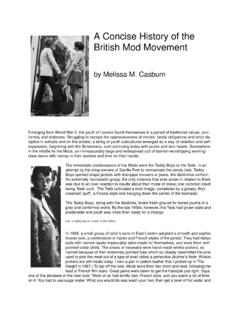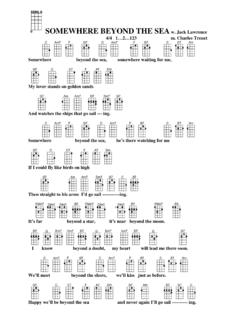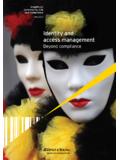Transcription of Dandyism: Beyond Fashion - GBACG Home
1 Dandyism: Beyond Fashion by Chevalier d'Hamilton Dandyism is the study of personal elegance and refinement. A dandy is he who seeks the perfection of his person. He is a man who regards himself as an unhewn marble on which to chisel his ideal. As the painter's spirit is reflected in his canvas, so the dandy is also reflected -- - in his own mirror. Like the painter, the dandy understands the elements of the aesthetic equation; line, colour, texture and form. How this equa- tion applies to the self sets the boundaries of the dandiacal art. Refine- ment is key to the dandy --- refinement in all things regarding his person;. his clothes, his motions, his wit and his tastes. The dandy and dandyism, thought the terms are somewhat archaic, have been forces in western culture for something over two centuries.
2 While the dandy has changed with the world around him, he has remained constant in his appreciation and application of the personal aesthetic. Sometimes a bohemian, sometimes an exclusive, always to varying degrees, a rebel, he has held a place in society and influenced history, not always avant garde, but always present. In the mid-1790's a young man entered into the fashionable life of London who would change the world. he was plainly different from his contemporaries and his difference was in his plainness. To a world in which Fashion was dictated by wealth and ostentatious display, George Bryan (Beau) Brummel (1778-1840). brought a new ethic of taste and restraint. In a word: refinement. Gone were the gaudy diamond buttons, gold chains, jeweled buckles and lace flounces.
3 Gone were the perfumes and powders. Brummel honed to the masculine essentials; an unadorned blue jacket with brass buttons, waistcoat, breeches, shirt and neckcloth. The prototype of modern dress. if the Beau was plain, he was perfectly plain. The emphasis was on cut, fit, style and cleanliness. His only complexity was in his laboriously tied white muslin, (not silk). cravat. His extravagances were few, limited to his gold watch fobs and snuff boxes. Not that he was cheap, his tailoring bills quite made up for what he failed to spend on other luxuries, for the Beau's clothes fit him like no one else's before. As a testament to this fact he managed to squander his entire inheritance by the time he was 38 years old. He was forced to flee his creditors for France, 40,000 pounds worse then noth- ing as the saying went.
4 Brummell also brought a new sense of cleanliness to society. Though his toilette took hours out of his day, the actual dressing took very little time. It was the washing that consumed all those hours. One result of this was that he was able to eschew fragrances with confidence. Through not himself an aristocrat, Brummel was able to dominate London society for most of the Regency and was a heavy influence, even in exile. To do this he not only refined his wardrobe, but honed his wit. Like his cloth- ing, Brummel's prose was minimalist. He stripped wit to its essentials, he could make or destroy reputa- tions with a word or glance. Brummel was a snob, but his snobbery was an innovation. Not merely based on pedigree, his was a snobbery of style, of Fashion .
5 The Beau's understated elegance, his refinement, his cleanliness and insistence on fresh linen set the standard in masculine dress that is still being followed today. Brummel's unique new mode of masculine dress was not without its influences. The order of the day in design and art was classicism. Greek and Roman formulaic ideals of aesthetics had been brought to England during the Renaissance. These ideals were most obviously applied in neo-classical architecture. The column, the arcade and the pediment were the mainstays of building design in Brummel's day. The most important classicist of the period was the French paint, Jacques-Louis David (1748-1825). Though mostly a painter, David influenced all aspects of design. His famous Portrait of Madame Recamier (1805, Musee du Louvre, Paris) shows a woman in a diaphanous white gown of draped muslin, reclining on a conspicuously Grecian chaise.
6 Yet, this is not a costume piece, the clothing and furniture are David's own contemporary adaptations of the Greek style. Though Brummel's new look didn't emulate Greek or Roman costume, as women's dress did, it was still classical in essence. What made Brummel Greek was that he followed an ideal of purely masculine beauty. Like David's paintings, like neo-classical architecture, Brummel distilled men's Fashion into an abstract ideal, a strict mode of thought. Rebellion to all this narrow idealism was inevitable and a new force now entered into the world. That force was personified in the being of Lord Byron. Byron and the romantics were not considered dan- dies in England. They shunned the stifling life of the city and yearned for the exotic, eccentric and sen- sual.
7 The classic-romantic split was formed. Though on separate paths the two groups felt no enmity toward one another. In fact, Byron considered Brum- mel (who, after all, was in his own time, a rebel) the most influential character of the 19th century after Napoleon and himself. The romantics created an opposite sort of image to that of the dandy. The romantic pose was always to appear casual, loose and a little wild. Pose is the key term; it was a casual- ness that was as highly and painstakingly cultivated as the upright perfection of the dandy. The romantics wore their collars open and unbuttoned to show their pale chests, causing the vapors in decent young ladies. Broad brimmed and soft hats kept their deli- cate complexions away from the sun, and loose, flowing scarves trailed behind their carriages.
8 Byron, in order to conceal his club-foot, wore long, loose trousers, an innovation that would become an abso- lute in half a century. Byron didn't actually invent long pants, but he was the first aristocrat to adopt them from the lower classes. Portrait of Lord Byron by Thomas Phillips, 1814. This portrait was first displayed at the Royal Academy Exhibition in 1814. Phillips also painted the famous portrait of Byron in Albanian dress. In 1815, Napoleon was finally defeated at Waterloo and the world rushed to Paris. English dandyism struck Paris like a thunderbolt. Of course, the French, with characteristic blind-sight, did not differentiate the dan- dies from the romantics. It all the Mode l'Anglaise and therefore, desirable. It is ironic that the Parisienne attitude has its' origins in the clubs of Regency London.
9 The French took dandyism and romanticism and weaved them into the fabric of French social life. They adopted the dandy and made him their own. In 1819 Beau Brummel fled England and his debts for a penurious exile on the French coast. There he lived out the remainder of his years, gradually losing touch with the qualities which made him great: pride, dignity and refinement. In 1840 he finally died, in a sanatorium in Caen screaming: Scoundrels, I owe nothing! Without Brummel's influence over them, the dandies of London began to slip into innovative extremes. One year might see a wasp waist, another a grotesquely over-sized lapel or an ultra narrow hat brim. Trousers might flair alarmingly for morning dress and then be super tight for evening.
10 Collars crept up and up until, finally, wearing one was like wearing blinders. In France fashionable young me blithely mixed dandiacal and romantic fashions, producing an entirely French effect. Brummel became a sort of Fashion icon in mid-century France, but in post-Regency Britain, Brummel's long decay and death in insanity gave ammunition to a burgeoning anti-dandiacal movement. Writers such as Thackeray and Carlyle, through periodicals such as Fraser's Magazine, waged an irre- pressible war against dandyism, effeminacy, puffery', and anything else they deemed useless or unmanly. Utilitarianism grew out of the Victorian rejection of Regency ideals (or perhaps its lack of ideals). With the Industrial Revolution plowing ahead at full steam, Regency dandyism and its' accompanying elitist doctrine were quickly becoming obsolete.






